Impacts of Strong El Niño–Southern Oscillation Events on Wintertime Northern Hemisphere Storm Tracks in Two Pacific Decadal Oscillation Phases during 1950–2010
Abstract
:1. Introduction
2. Data and Methods
2.1. Data
2.2. Methods
3. Results
3.1. Different Combinations of ENSO and PDO and Their Impacts on Storm Tracks
3.2. Nonlinear Modulation of PDO on ENSO’s Impact
4. Conclusions
5. Discussion
Author Contributions
Funding
Institutional Review Board Statement
Informed Consent Statement
Data Availability Statement
Conflicts of Interest
References
- Blackmon, M.L. A climatological spectral study of the 500 mb geopotential height of the Northern Hemisphere. J. Atmos. Sci. 1976, 33, 1607–1623. [Google Scholar] [CrossRef]
- Chang, E.K.M.; Lee, S.; Swanson, K.L. Storm track dynamics. J. Clim. 2002, 15, 2163–2183. [Google Scholar] [CrossRef]
- Chang, E.K.M.; Zheng, C.; Lanigan, P.; Yau, A.M.W.; Neelin, J.D. Significant modulation of variability and projected change in California winter precipitation by extratropical cyclone activity. Geophys. Res. Lett. 2015, 42, 5983–5991. [Google Scholar] [CrossRef]
- Lu, J.; Greatbatch, R.J. The changing relationship between the NAO and Northern Hemisphere climate variability. Geophys. Res. Lett. 2002, 29, 52-1–52-4. [Google Scholar] [CrossRef]
- Feser, F.; Barcikowska, M.; Krueger, O.; Schenk, F.; Weisse, R.; Xia, L. Storminess over the North Atlantic and northwestern Europe-a review. Q. J. R. Meteorol. Soc. 2015, 141, 350–382. [Google Scholar] [CrossRef]
- Chu, C.J.; Hu, H.B.; Yang, X.-Q.; Yang, D.J. Midlatitude Atmospheric transient eddy feedbacks influenced ENSO-associated wintertime Pacific teleconnection patterns in two PDO phases. Clim. Dyn. 2020, 54, 2577–2595. [Google Scholar] [CrossRef]
- Nakamura, H.; Sampe, T.; Goto, A.; Ohfuchi, W.; Xie, S.P. On the importance of midlatitude oceanic frontal zones for the mean state and dominant variability in the tropospheric circulation. Geophys. Res. Lett. 2008, 35, L15709. [Google Scholar] [CrossRef]
- Kobashi, F.; Xie, S.P.; Iwasaka, N.; Sakamoto, T. Deep atmospheric response to the North Pacific oceanic subtropical front in spring. J. Clim. 2008, 21, 5960–5975. [Google Scholar] [CrossRef]
- Zhang, Y.; Held, I.M. A linear stochastic model of a GCM’s midlatitude storm tracks. J. Atmos. Sci. 1999, 56, 3416–3435. [Google Scholar] [CrossRef]
- Son, S.-W.; Ting, M.F.; Polvani, L.M. The effect of topography on storm-track intensity in a relatively simple general circulation model. J. Atmos. Sci. 2009, 66, 393–411. [Google Scholar] [CrossRef]
- Shaw, T.A.; Baldwin, M.; Barnes, E.A.; Caballero, R.; Garfinkel, C.I.; Hwang, Y.-T.; Li, C.; O’Gorman, P.A.; Rivière, G.; Simpson, I.R. Storm track processes and the opposing influences of climate change. Nat. Geosci. 2016, 9, 656–664. [Google Scholar] [CrossRef]
- Straus, D.M.; Shukla, J. Variations of midlatitude transient dynamics associated with ENSO. J. Atmos. Sci. 1997, 54, 777–790. [Google Scholar] [CrossRef]
- Zhu, W.J.; Sun, Z.B.; Zhou, B. The impact of Pacific SSTA on the interannual variability of Northern Pacific storm track during in winter. Adv. Atmos. Sci. 2001, 18, 1029–1042. [Google Scholar]
- Hoerling, M.P.; Kumar, A. Atmospheric response patterns associated with tropical forcing. J. Clim. 2002, 15, 2184–2203. [Google Scholar] [CrossRef]
- Liu, Z.Y.; Alexander, M. Atmospheric bridge, oceanic tunnel, and global climatic teleconnections. Rev. Geophys. 2007, 45, RG2005. [Google Scholar] [CrossRef]
- Alexander, M.A.; Bladé, I.; Newman, M.; Lanzante, J.R.; Lau, N.-C.; Scott, J.D. The atmospheric bridge: The influence of ENSO teleconnection on air–sea interaction over the global oceans. J. Clim. 2002, 15, 2205–2231. [Google Scholar] [CrossRef]
- Horel, J.D.; Wallace, J.M. Planetary scale phenomena associated with the Southern Oscillation. Mon. Weather Rev. 1981, 109, 813–829. [Google Scholar] [CrossRef]
- Wang, B.; Wu, R.G.; Fu, X. Pacific–East Asian teleconnection: How does ENSO affect East Asian climate. J. Clim. 2000, 13, 1517–1536. [Google Scholar] [CrossRef]
- Mantua, N.J.; Hare, S.R.; Zhang, Y.; Wallace, J.M.; Francis, R.C. A Pacific interdecadal climate oscillation with impacts on salmon production. Bull. Amer. Meteor. Soc. 1997, 78, 1069–1079. [Google Scholar] [CrossRef]
- Yu, B.; Shabbar, A.; Zwiers, F.W. The enhanced PNA-like climate response to Pacific interannual and decadal variability. J. Clim. 2007, 20, 5285–5300. [Google Scholar] [CrossRef]
- Hu, Z.-Z.; Huang, B. Interferential impact of ENSO and PDO on dry and wet conditions in the U.S. Great Plains. J. Clim. 2009, 22, 6047–6065. [Google Scholar] [CrossRef]
- Poli, P.; Hersbach, H.; Dee, D.P. ERA-20C: An atmospheric reanalysis of the twentieth century. J. Clim. 2016, 29, 4083–4097. [Google Scholar] [CrossRef]
- Zhang, Y.; Wallace, J.M.; Battisti, D.S. ENSO-like interdecadal variability: 1900–93. J. Clim. 1997, 10, 1004–1020. [Google Scholar] [CrossRef]
- Wallace, J.M.; Lim, G.H.; Blackmon, M.L. Relationship between cyclone tracks, anticyclone tracks, and baroclinic waveguides. J. Atmos. Sci. 1988, 45, 439–462. [Google Scholar] [CrossRef]
- Takaya, K.; Nakamura, H. A formulation of a phase-independent wave-activity flux for stationary and migratory quasigeostrophic eddies on a zonally-varying basic flow. J. Atmos. Sci. 2001, 58, 608–627. [Google Scholar] [CrossRef]
- Cai, M.; Mak, M. Symbiotic relation between planetary and synoptic-scale waves. J. Atmos. Sci. 1990, 47, 2953–2968. [Google Scholar] [CrossRef]
- Hoskins, B.J.; Valdes, P.J. On the existence of storm tracks. J. Atmos. Sci. 1990, 47, 1854–1864. [Google Scholar] [CrossRef]
- Chelliah, M.; Bell, G.D. Tropical multidecadal and interannual climate variability in the NCEP-NCAR Reanalysis. J. Clim. 2004, 17, 1777–1803. [Google Scholar] [CrossRef]
- Li, Y.; Lau, N.-C. Impact of ENSO on the atmospheric variability over the North Atlantic in late winter-role of the transient eddies. J. Clim. 2012, 25, 320–342. [Google Scholar] [CrossRef]
- Ning, L.; Bradley, R.S. Winter precipitation variability and corresponding teleconnections over the northeastern United States. J. Geophys. Res. 2014, 119, 7931–7945. [Google Scholar] [CrossRef]
- Yu, B.; Zwiers, F.W. The impact of combined ENSO and PDO on the PNA climate: A 1000-year climate modeling study. Clim. Dyn. 2007, 29, 837–851. [Google Scholar] [CrossRef]

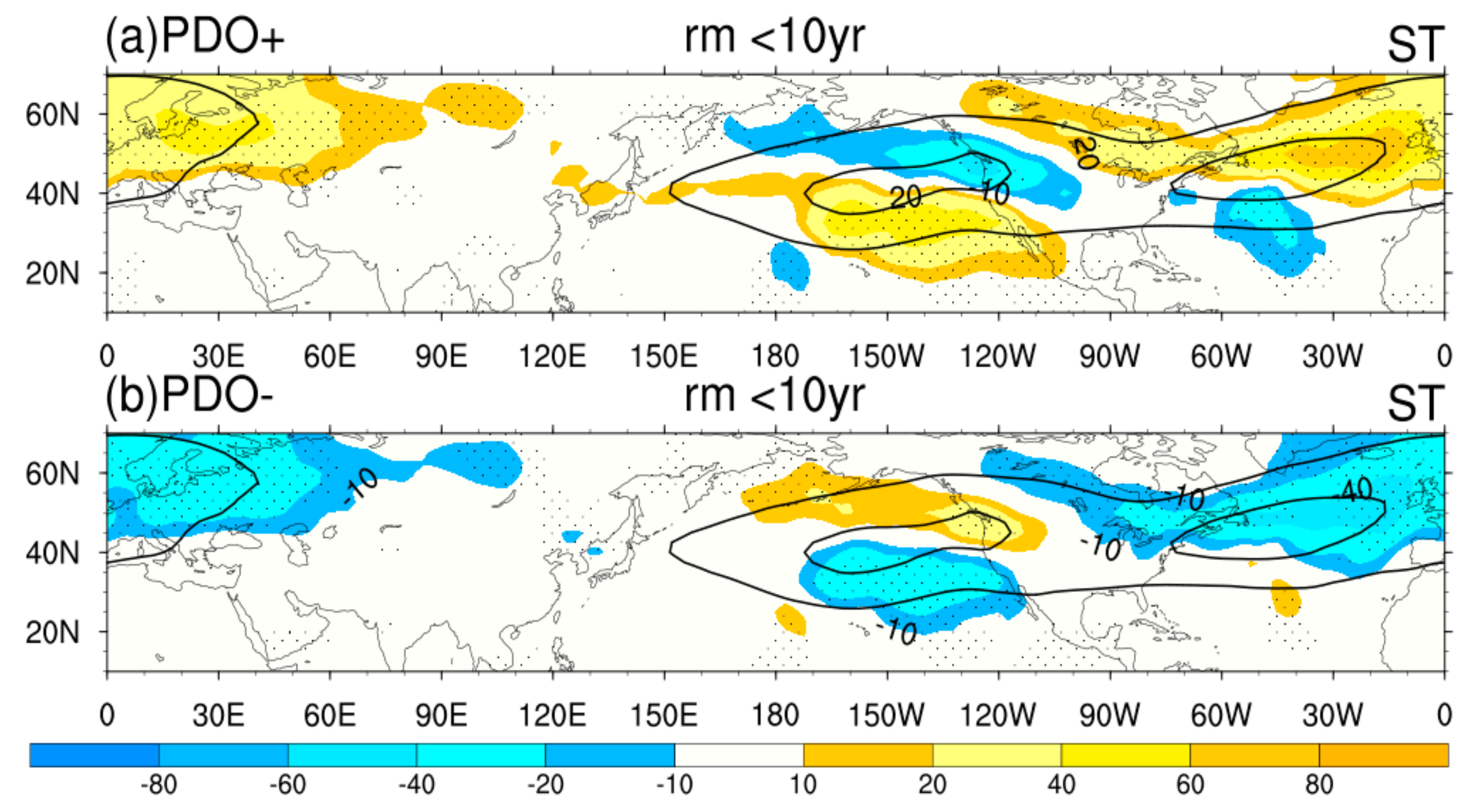
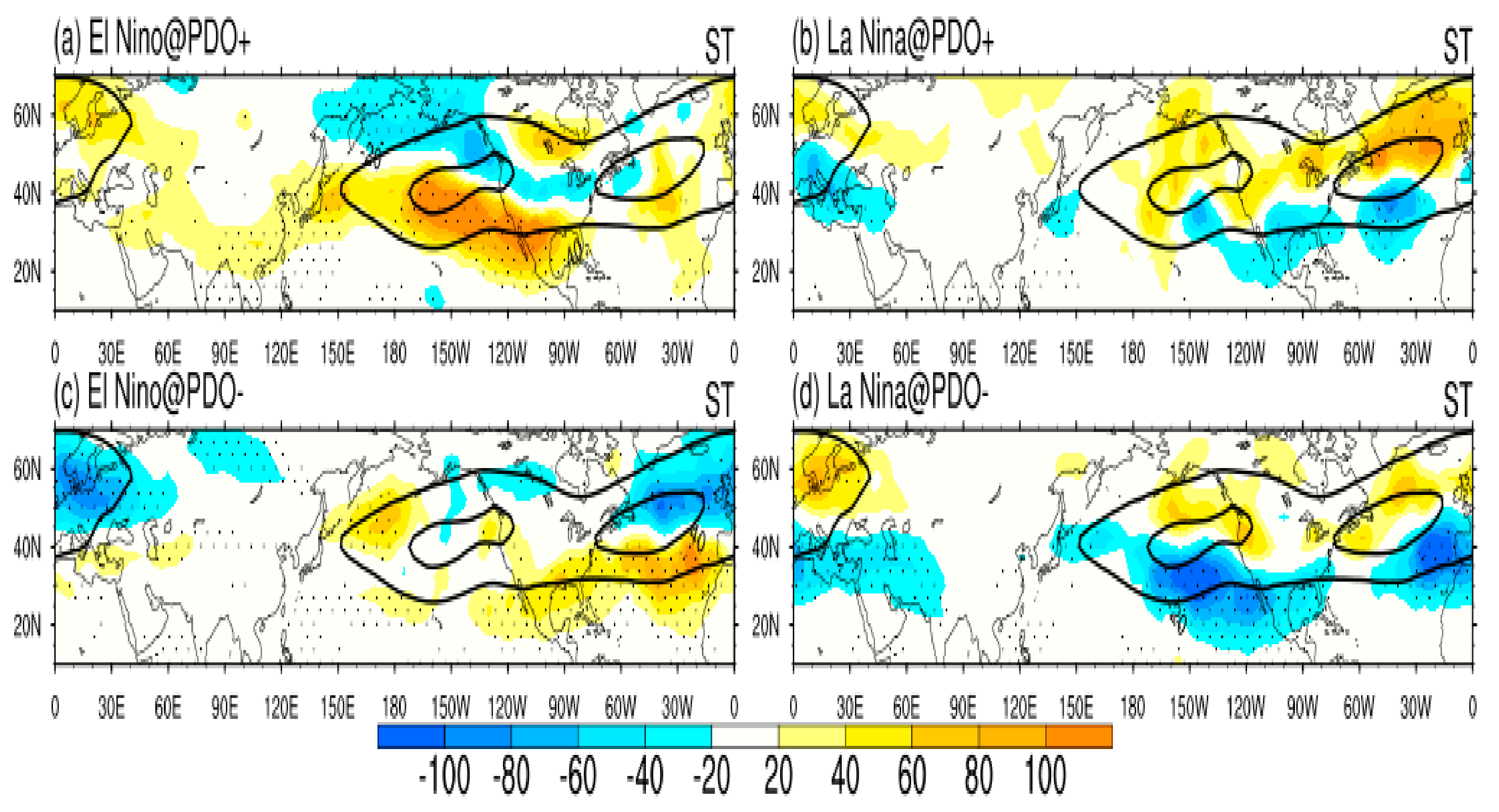
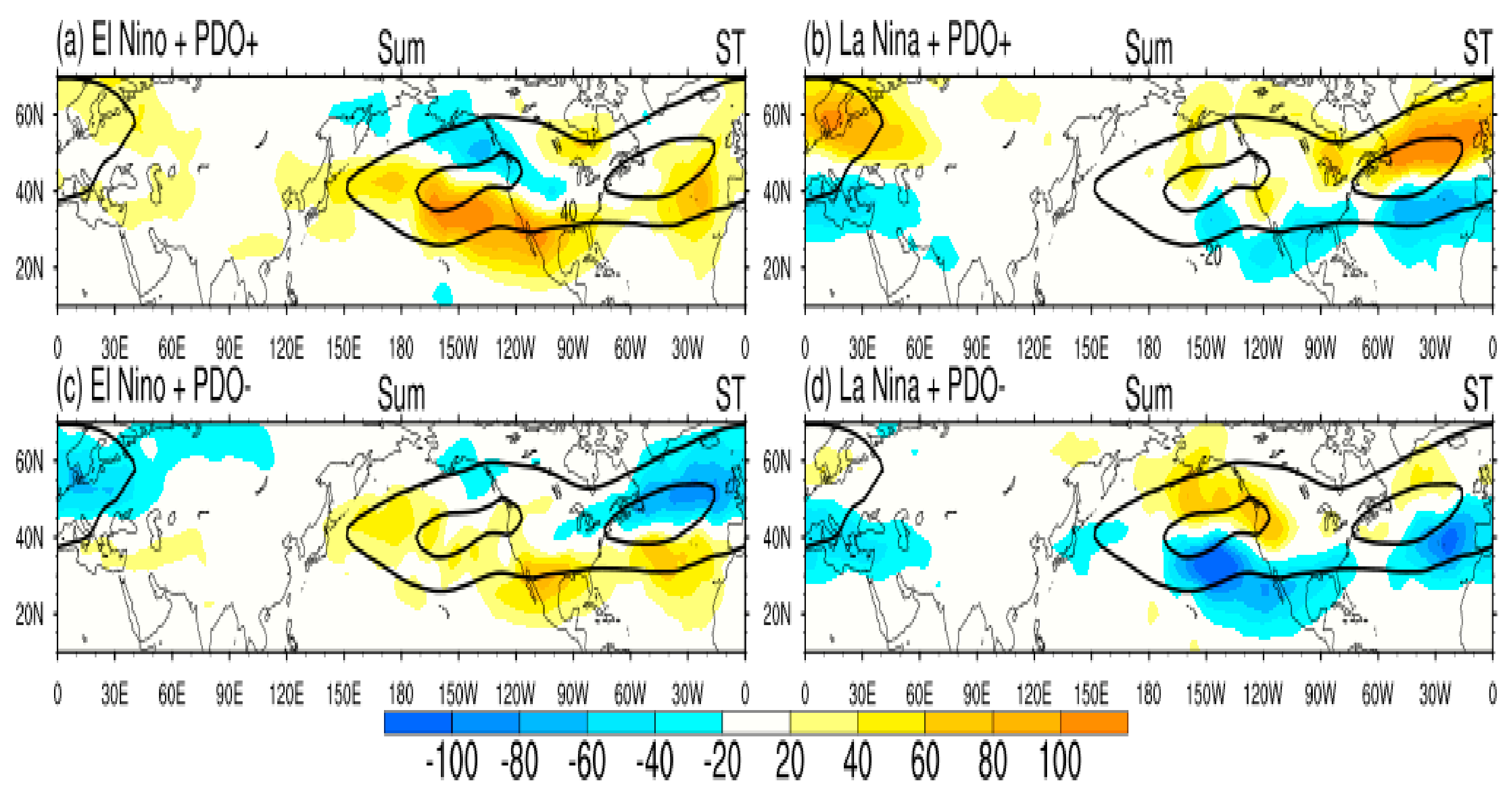
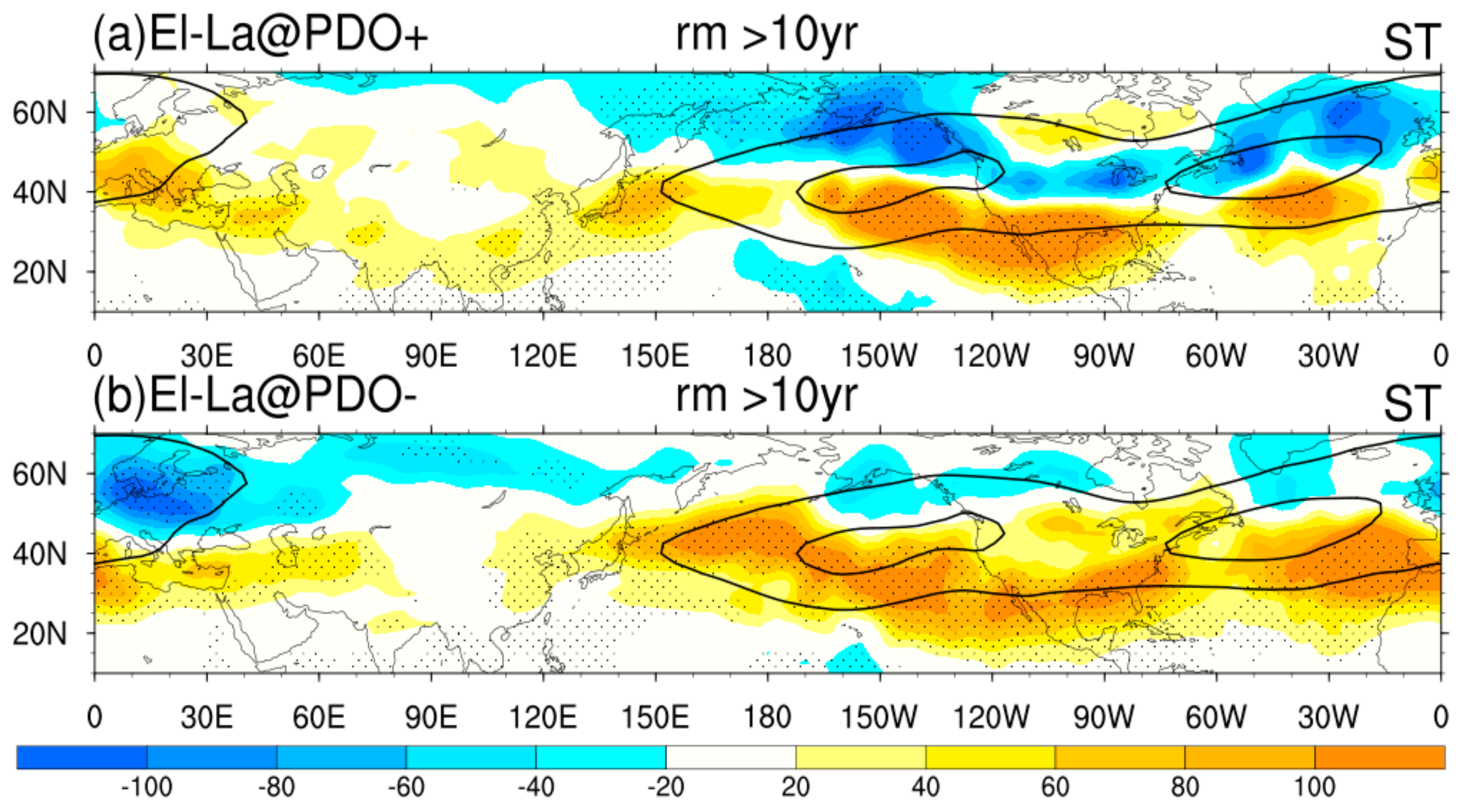
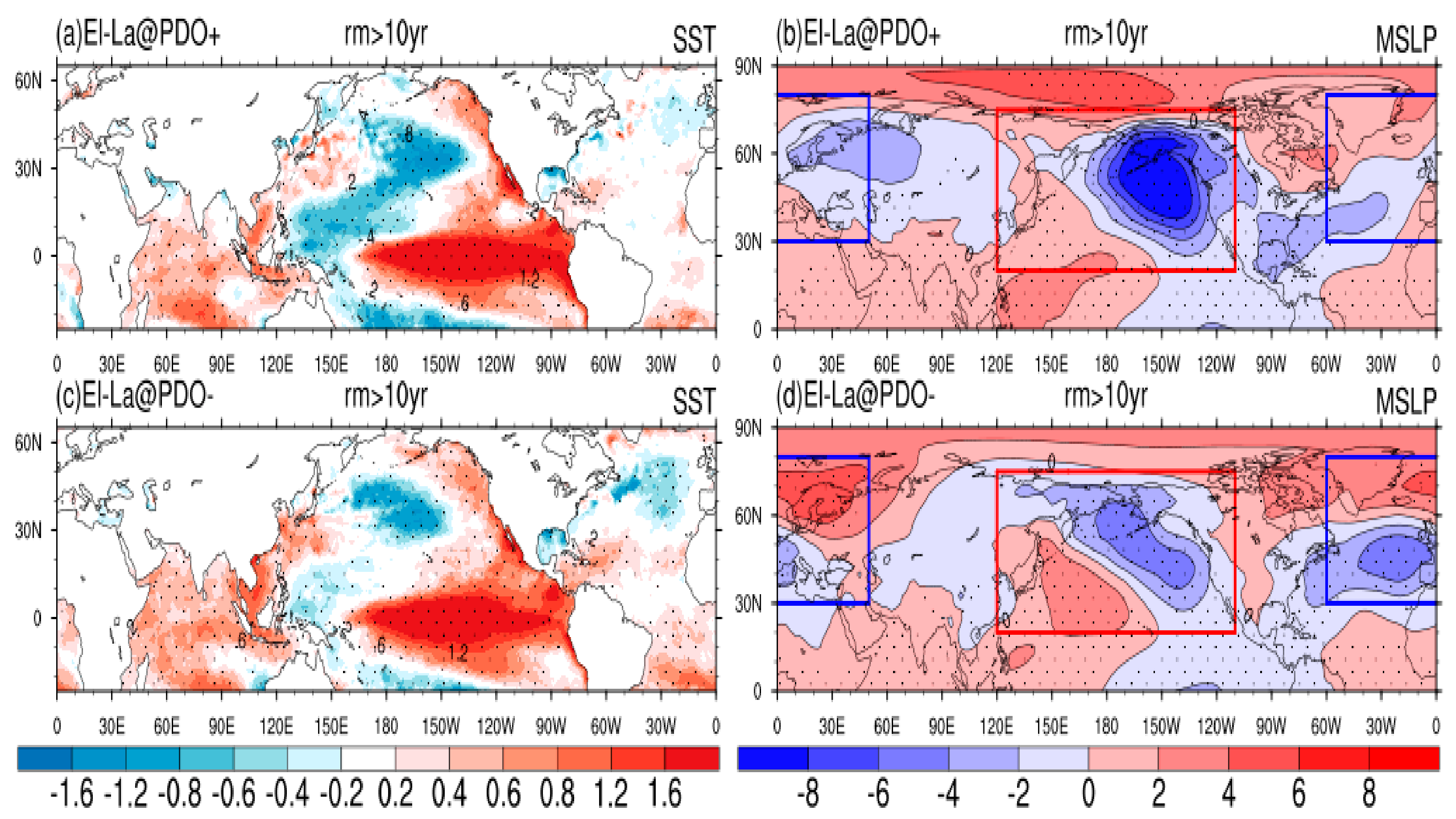
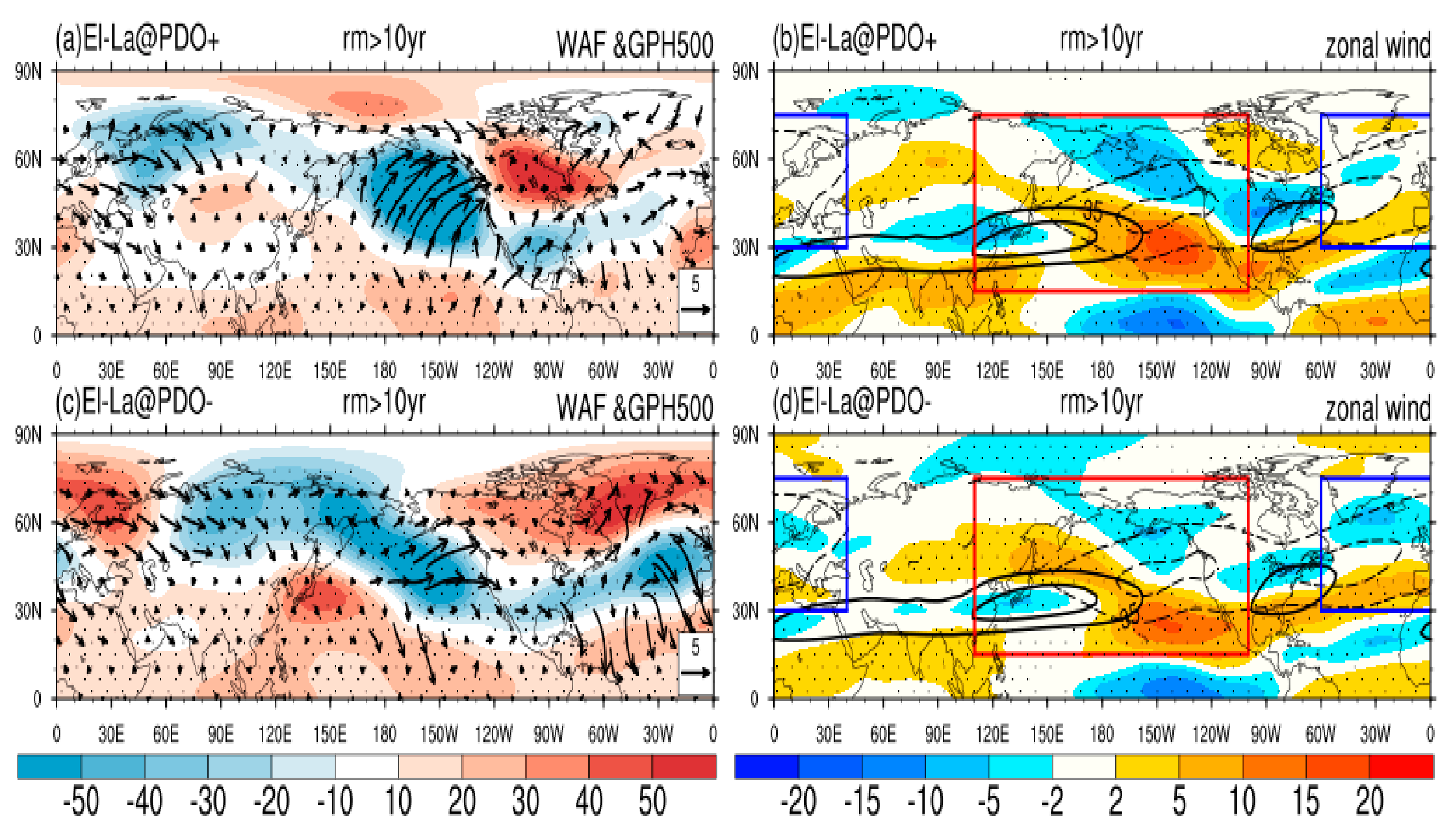



| PDO Positive | PDO Negative | |
|---|---|---|
| El Niño | 1982/83, 1986/87, 1987/88, 1991/92, 1997/98, 2002/03 | 1953/54, 1957/58, 1963/64, 1965/66, 1968/69, 1972/73, 2009/10 |
| La Niña | 1984/85, 1988/89, 1995/96, 1998/99 | 1955/56, 1970/71, 1973/74, 1975/76, 1999/2000, 2007/08 |
Disclaimer/Publisher’s Note: The statements, opinions and data contained in all publications are solely those of the individual author(s) and contributor(s) and not of MDPI and/or the editor(s). MDPI and/or the editor(s) disclaim responsibility for any injury to people or property resulting from any ideas, methods, instructions or products referred to in the content. |
© 2023 by the authors. Licensee MDPI, Basel, Switzerland. This article is an open access article distributed under the terms and conditions of the Creative Commons Attribution (CC BY) license (https://creativecommons.org/licenses/by/4.0/).
Share and Cite
Chu, C.; Yang, X.-Q.; Sun, X.; Ren, X.; Chang, E.K.M.; Fang, J.; Hu, H. Impacts of Strong El Niño–Southern Oscillation Events on Wintertime Northern Hemisphere Storm Tracks in Two Pacific Decadal Oscillation Phases during 1950–2010. Sustainability 2023, 15, 16565. https://doi.org/10.3390/su152416565
Chu C, Yang X-Q, Sun X, Ren X, Chang EKM, Fang J, Hu H. Impacts of Strong El Niño–Southern Oscillation Events on Wintertime Northern Hemisphere Storm Tracks in Two Pacific Decadal Oscillation Phases during 1950–2010. Sustainability. 2023; 15(24):16565. https://doi.org/10.3390/su152416565
Chicago/Turabian StyleChu, Cuijiao, Xiu-Qun Yang, Xuguang Sun, Xuejuan Ren, Edmund K. M. Chang, Jiabei Fang, and Haibo Hu. 2023. "Impacts of Strong El Niño–Southern Oscillation Events on Wintertime Northern Hemisphere Storm Tracks in Two Pacific Decadal Oscillation Phases during 1950–2010" Sustainability 15, no. 24: 16565. https://doi.org/10.3390/su152416565
APA StyleChu, C., Yang, X.-Q., Sun, X., Ren, X., Chang, E. K. M., Fang, J., & Hu, H. (2023). Impacts of Strong El Niño–Southern Oscillation Events on Wintertime Northern Hemisphere Storm Tracks in Two Pacific Decadal Oscillation Phases during 1950–2010. Sustainability, 15(24), 16565. https://doi.org/10.3390/su152416565






